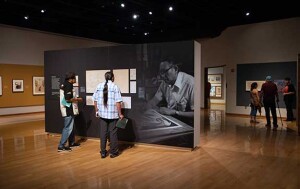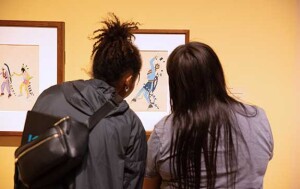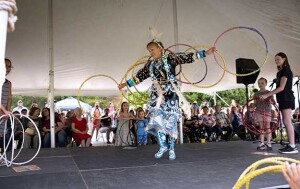“Dakota Modern: The Art of Oscar Howe,” a retrospective exhibition celebrating the Yanktonai Dakota artist’s work, had a big impact on the South Dakota Art Museum while it was on display June 10-Sept. 17 at South Dakota State University.
It, along with “Continuum: Honoring Oscar Howe’s Legacy,” the South Dakota Art Museum-curated companion exhibition featuring artworks by students of Howe and their protegees, definitely increased traffic at the museum this summer. And some of those visitors, seeing the exhibit on the final stop of its national tour, likely made the trip to the museum for the first time.
But for museum director Donna Merkt, the biggest win for the museum goes beyond that. She points to all the relationship building and community involvement that resulted from the ”blockbuster” exhibit, which featured more than 60 of Howe’s works.
“The most important thing is that we have demonstrated a high commitment to connecting with and celebrating Native artists in our region and beyond. It’s about relationship-building and the quality of the experience. This has been an incredible, quality experience for all who have visited,” Merkt said.
“Oscar Howe was a rule-breaker, and he busted stereotypes in the art world and beyond. He really removed barriers for Native artists, demonstrating that they don’t have to stay in the confines set for them by the art world, that their art can be what they want it to be, and they can always grow beyond that if they choose,” Merkt added.
 “Dakota Modern” was curated by Kathleen Ash-Milby and organized by the Smithsonian’s National Museum of the American Indian and the Portland Art Museum. It opened at the Smithsonian’s National Museum of the American Indian in New York City in March 2022 and traveled to the Portland Art Museum, where it closed May 14 before coming to Brookings.
“Dakota Modern” was curated by Kathleen Ash-Milby and organized by the Smithsonian’s National Museum of the American Indian and the Portland Art Museum. It opened at the Smithsonian’s National Museum of the American Indian in New York City in March 2022 and traveled to the Portland Art Museum, where it closed May 14 before coming to Brookings.
The Henry Luce Foundation, the Andy Warhol Foundation for the Visual Arts, and the Wyeth Foundation for American Art all contributed to funding the exhibition.
The presentation in South Dakota was supported by many donors including First Bank & Trust, an anonymous supporter, SDSU’s Office of the President and the Wokini Initiative, Venance ’71/M.S. ’74/Ph.D. ’77 and Deborah ’74 Lengkeek, and Meyer Orthodontics.
Merkt said the museum advocated very strongly for the exhibit to come to Howe’s home state so his relatives and the people of South Dakota could appreciate it and not have to go to Portland or Manhattan to see it.
The museum worked on bringing the Howe exhibit to Brookings for a solid two years before its opening. The curation process started about seven years ago.
The South Dakota Art Museum is an American Alliance of Museums-accredited facility, Merkt said. ”That was important for demonstrating that our facility met the highest professional standards for collections care, and that our small team could handle this exhibition. It was a large undertaking. … I think we exceeded national expectations.”
The museum needed to be nimble in hosting the exhibit. ”What would be fantastic is to have this kind of exhibition and still have more of our permanent collection on display,” Merkt said. “Our struggle is still with our space. It’s hard to turn over an entire museum.” 
Explaining to non-art aficionados how big a deal bringing the exhibit to Brookings was, Merkt compared it to ESPN’s “GameDay” coming to campus. Others likened it to the Super Bowl. Those familiar with the museum could also see the impact just in how the exhibit was installed: the color and graphics on the walls, the museum closing for a month for installation, the layout and more.
Merkt sees the Howe exhibit as having created potential for the South Dakota Art Museum to partner with other museums and giving SDAM more ability to vie for nationally acclaimed exhibitions.
A big part of the museum’s relationship building was done through its companion exhibit, “Continuum.” It helped achieve the engagement and depth that the New York and Portland museums did not fully realize. “That’s where we really shined. … As soon as we knew we were getting this exhibition, we started engaging with the Native community to ask, ‘How do we do this right?’” Merkt said.
The museum’s engagement team focused on outreach, so that anyone who wanted to celebrate Howe with the museum could do so. That included travel grants for tribal-affiliated organizations to come and see the exhibition. Travel grants were also introduced for K-12 schools and remain an ongoing offering by the museum.
Similarly, a mini pop-up exhibition about Howe, his art and his life was created in honor of the exhibit and continues to travel free to schools, community centers and libraries.
Community celebration grants aided in hosting Howe-related events throughout South Dakota, including a powwow at Crow Creek and a companion exhibit at the John A. Day Gallery at the University of South Dakota, further exploring the generational impact of Howe’s legacy.
“The South Dakota Art Museum has been honored to host this incredible exhibition and share the work of an amazing artist who means so much to the people of our state and beyond. This exhibition epitomizes the museum’s mission to inspire creativity, connect people and enrich lives through art,” Merkt said.
Next for the museum is an exhibition featuring Signe Stuart, retired fine art faculty from SDSU.
‘”Signe Stuart: Events in Time and Space,” a retrospective of Stuart’s career spanning more than six decades, will have a soft opening Hobo Day weekend. It features large-scale works, including a walk-through installation piece that will debut during the opening celebration Oct. 21.
Jill Fier






